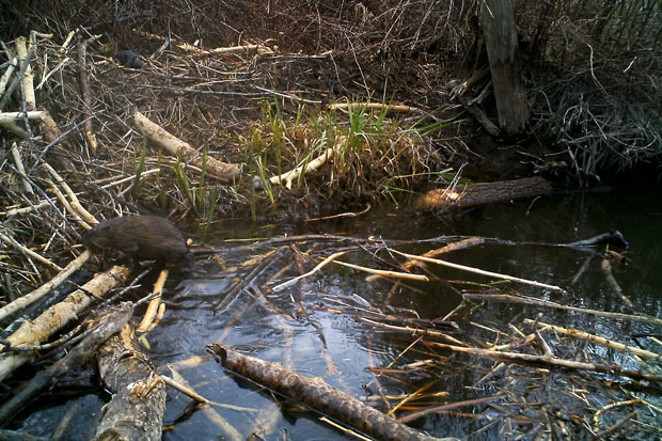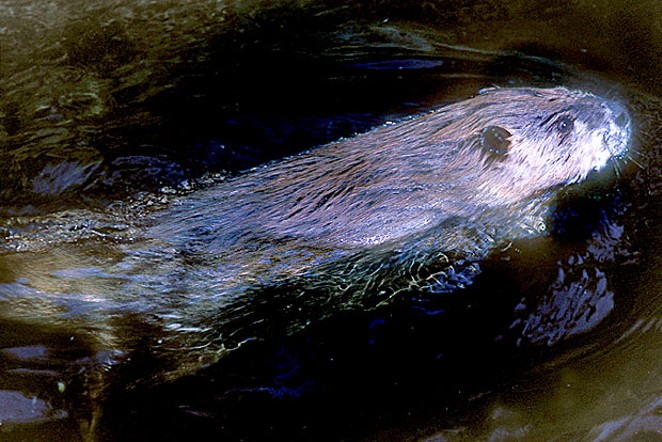No matter how you look at the history of the Pacific Northwest, one native animal stands out in making Oregon what it is today: the North American Beaver. Yes, the same one we see on our state flag.
As far as you can go back into the history of the Northwest you will find the beaver supplying the material early people required to stay alive financially and make a home for themselves. The cities of Astoria and Portland, for example, can thank the beaver for their growth and welfare.

Beaver were slaughtered for their value in making hats, coats and money, lots of money. When the founders of this country wanted to keep beaver out of the hands of the British, they went out and slaughtered them so they couldn't be used by any foreign nation to compete with our commerce.
Well, today, the beaver has an equal degree of importance, but in the area of water conservation. They don't need to be killed and their skins sold to be of great value to Man. Killing and skinning beaver for their pelts should be eliminated thanks to comparable fabricated items.
We have the industrious beaver to thank for helping keep the water available for us to drink, cook with, flush our toilets with, irrigate with, and use as we will in hundreds of other ways.
tweet this
But as a positive factor in water conservation, beaver have no equal, and the knowledge of how they function in this all-important role is just becoming known to us.
Our native beaver is one colossal rodent, the largest in all of North America, and nearly matches its Eurasian cousin as being the largest rodent in the world. Just one of our species tips the scales at up to 78 pounds of muscle, teeth and tail.
The beaver is an industrious critter with gigantic, ultra-sharp teeth that eats trees and has a tail that is humungous, flat, and when it wants to it can slap it on the surface of the water to be heard a great distance away.

A best-selling and well-written treatise on beaver was written by Ben Goldfarb, entitled "Eager, The Surprising, Secret Life of Beavers and Why They Matter." According to National Geographic, "Eager takes us inside the amazing world of nature's premier construction engineer...and shows us why the restoration of an animal almost driven to extinction is producing wide-ranging, positive effects on our landscapes, ecology, and even our economy." Go get it; a book well worth the read.
Now, right up front it is necessary to point out the one negative influence beaver have on part of our society: they need and enjoy cutting down trees, especially those on the banks of rivers and streams in people's backyards.
There is nothing decorative about cottonwoods, alders and other landscaping to a beaver. In their way of looking at the habitat they live within, such plants are necessary food and building materials for adjusting the landscape to their needs. After collecting such vegetation the beavers haul it off to their home, or, use it to build their well known, remarkable dams.
The water impounded by these dams is what a beaver is after. They build their stick and soil homes in the ponds to keep them safe from predators and provide a place to start a family. And it is that water that makes the beaver irreplaceable in creating one of the best resources for water conservation.
The water keeps rising behind the dams and eventually will become part of our underground aquifers vital to so many parts of human civilization. For that reason, there are several conservation organizations restoring beavers to their native habitats. On the other hand, there are those who—because of the beaver's tree-eating habits—have declared them a "predator," thereby allowing them to be removed from the landscape with impunity.
Being classified as a "predator," beaver can be killed at any time in any way and no one has to even report it. That takes the beaver out of the hands of wildlife managers and contradicts the work being carried out to reintroduce the beaver to our landscape as aquifer engineers.
Like it or not, everyone who uses water is unknowingly depending on the dam-building talents of our North American Beaver. Without question, we have the industrious beaver to thank for helping keep the water available for us to drink, cook with, flush our toilets with, irrigate with, and use as we will in hundreds of other ways.
A new pro-beaver organization has come to the fore in Central Oregon, "Beaver Oregon Works." If you live on a stream or river and have landscape that may be at risk to being utilized by a beaver, go to their web site, beaverworks.org, or email them at: [email protected]. Their field technicians can mitigate any beaver issues you may be encountering.
This organization states that beavers create wetlands and are the "Earth's Kidney" and as such provide downstream drought and flood protection, water table and aquifer recharge and improved water quality. They even help bring back salmon to the Northwest. That is not what "predators" do.
Removal of beaver from their ancestral habitats has wrought the alteration of many ecosystems, causing flooding, drying up of marshes, plus loss of salmon and other wildlife environments.
As we now face drought conditions in our area, let's cheer these tireless water savers on and help, not hurt them.























